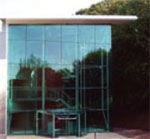Donors dream big
by María José Viñas
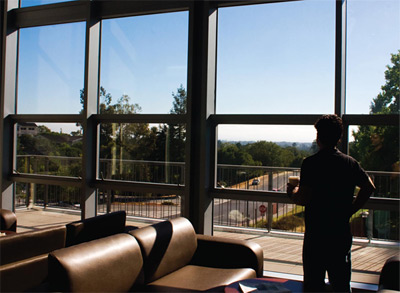 |
| Physicists and visitors to the Kavli Institute for Particle Astrophysics and Cosmology, established with the aid of a grant from the Kavli foundation, enjoy the view from its Stanford Linear Accelerator Center building, which opened in 2006. Photo: David Harris |
Drawn by the chance to help answer the most fundamental questions about the universe, philanthropists are starting to make significant investments in physics research.
"When you grow up
under the northern light
and the Milky Way, you get close to nature and get an interest in it."
—Fred Kavli
At first glance, particle physics seems to be a rather arid land in which to plant the seeds of philanthropy; much of the research in the field requires gigantic machines with budgets to match. Instead, many philanthropists prefer to put their money into areas such as medical research, where the science is more comprehensible and their investments have more immediate returns with clearer social benefits.
Yet while money for physics research still comes almost exclusively from government agencies, such as the Department of Energy and the National Science Foundation in the United States, private donors are starting to have an impact, contributing millions and setting a path for others to follow.
The best-known examples of physics philanthropy are the Kavli institutes and the Perimeter Institute for Theoretical Physics, as well as a surprising donation that allowed the Brookhaven National Laboratory accelerator to keep running after a severe budget cut. More modest gifts have made a difference, too, including endowments that fund professorships at universities. In all cases, the donors have a common trait: they are smitten by physics.
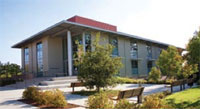 |
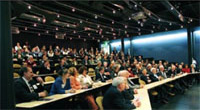 |
|
Based at Stanford University and Stanford Linear Accelerator Center, the Kavli Institute for Particle Astrophysics and Cosmology is one of 15 research institutions being funded by industrialist Fred Kavli through a foundation he set up. Another philanthropist, Pierre Schwob, donated $1 million to create a computing center at the institute. Photos: Diana Rogers, SLAC |
"There are many opportunities for seeing returns when investing in physics," says Roger Blandford, director of the Kavli Institute for Particle Astrophysics and Cosmology at Stanford University and Stanford Linear Accelerator Center–"from being able to help a young person in their career, to being able to provide a crucial piece of an apparatus which will enable a wonderful discovery, or to providing, as Fred Kavli did here, a wonderful building with a view to the San Francisco Bay."
Private donations normally do not come alone, points out Kate Beers, associate director for physical sciences at the Office of Science and Technology Policy. They're usually matched by contributions from local governments, universities, or industries. "These coordinations are critical, and the more we can document and learn from them, the better," she says, adding that she believes industrial and philanthropic partnerships are going to be the new modes of financing physics research in the future.
A growing network
The center Blandford directs is one of 15 research institutions the Kavli Foundation has built or is planning to create at top-notch universities in the United States, China, and Europe. These institutes focus on astrophysics, nanoscience, and neuroscience.
In just six years, Fred Kavli, director of the foundation, has become one of the world's most prominent science philanthropists. Kavli, a Norwegian-born industrialist, says he discovered a passion for science many years before he studied physics at the Norwegian Institute of Technology.
"When you grow up in a country like Norway, under the northern light and the blue and dark skies in the winter, with the splendid stars and the Milky Way, you get close to nature and get an interest in it," Kavli says. "I think physics is the science closest connected with nature in general, and the universe."
Kavli, who emigrated to the United States just after receiving his engineering physics degree, made his fortune in the precision-sensor industry and became a science philanthropist after selling his company for $345 million in 2000.
"I like to look forward into the future and look at what is really of long-range benefit, and that is what I'm aiming to do," Kavli says. "And also, of course, I think there isn't enough support for basic science. It's harder for people to back things that fall far into the future, and therefore more support is needed."
Together with the Norwegian Academy of Science and the Norwegian Ministry of Education and Research, the foundation is also launching three annual prizes of $1 million each for seminal advances in the areas of astrophysics, neuroscience, and nanoscience. With these prizes, the foundation is trying to give scientists more visibility, Kavli says.
 |
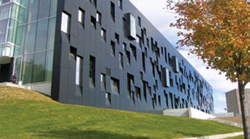 |
|
The Perimeter Institute for Theoretical Physics was created in 2000 with a donation from Mike Lazaridis, founder of the company that makes BlackBerry hand-held devices. The Canadian institute also gets public funding to run day-to-day operations. Photos: Perimeter Institute |
A pivotal party
A predecessor of Fred Kavli was the late William I. Fine, a businessman and developer from Minnesota who in 1987 promoted the creation of the Fine Theoretical Physics Institute at the University of Minnesota.
Stephen Gasiorowicz, a professor emeritus in physics at the university, says he met Fine at a party in the early 1980s. "He had been doing a lot of Scientific American-type reading, started asking me questions, and it became obvious he read more than the average person at a cocktail party," Gasiorowicz says. Some time later, Fine told Gasiorowicz he wanted to contribute to the development of physics, and the professor suggested he create a theoretical physics institute. But the endeavor would be more difficult than either of them could have predicted.
"We tried to raise some money from foundations and so on," Gasiorowicz says, but found them much less willing to fund theoretical physics than medical research. Eventually the professor and the industrialist gained the support of the University of Minnesota, which matched Fine's $2 million investment. The Fine Theoretical Physics Institute officially came into existence in January 1987, just before the Soviet Union broke up and allowed scientists to leave the country.
"Within a very short time we had five top-notch Russian physicists joining the department," Gasiorowicz recalls. "It was a very lively time for physics."
Gasiorowicz thinks Fine was a rara avis among philanthropists of his time: "What Bill did was sort of unusual. People preferred giving money to telescopes so that their name was attached to an object."
Investing in theory
Theoretical physics has turned out to be a popular area for philanthropists interested in science. It doesn't require expensive machinery, and the opportunities to contribute to the advancement of science through innovative ideas are immense. That may be why Mike Lazaridis decided to donate C$100 million (US$94 million) in 2000 to create the Perimeter Institute for Theoretical Physics in Waterloo, Canada. Lazaridis, founder and co-CEO of Research In Motion–manufacturer of BlackBerry handheld devices– also convinced two fellow executives in the company to invest C$10 million each to create the research center, which has quickly become a world leader in theoretical quantum physics and other disciplines.
John Matlock, director of communications for the institute, says it operates on a unique economic model, running day-to-day operations with public funding while keeping private donations in an endowment to safeguard the longer-term future.
"Researchers enjoy the multi-disciplinary environment," Matlock says. "They also appreciate the opportunity to host international conferences and high-level workshops. And with about 300 visitors each year from all around the world, there is a lot of productive collaboration taking place at PI."
This physics paradise is possible thanks to Lazaridis' vision of science, Matlock adds: although Lazaridis chairs the Perimeter Institute board, he gives researchers "much freedom" to pursue what interests them.
This non-invasive approach is common to other physics philanthropists, such as Fred Kavli.
"He's trusted us to steer the science and the investment along directions we think will be fruitful," says Blandford of Stanford's Kavli Institute, "and I think he's been very wise in doing that."
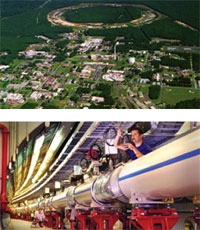 |
|
When budget cuts threatened to close the Relativistic Heavy Ion Collider at Brookhaven National Laboratory, Jim Simonsfounder and president of the hedge fund Renaissance Technologies Corporationdonated $13 million to keep it running. Photos: BNL |
FQXi tries to answer "deep, perennial questions not likely to get funding from the National Science Foundation."
—Charles Harper
Unconventional benefactors
Sometimes funding comes from unexpected sources. That is the case for Foundational Questions in Physics & Cosmology (FQXi), a virtual institute that seeks to promote paradigm-shifting research in physics and cosmology. It was launched in 2006 with a $6 million seed grant from the Templeton Foundation, which aims "to serve as a philanthropic catalyst for discovery in areas engaging life's biggest questions."
Anthony Aguirre, associate scientific director of FQXi, acknowledges that some people in the scientific community are suspicious of the Templeton Foundation because it has been accused in the past of giving money to conservative groups, as well as to scientists and centers, such as the Discovery Institute, which support intelligent design.
"We got a seed grant from them, but it is no strings attached," Aguirre says. "This is an independent institution and hopefully in the future there will be other funds from other donors."
Charles Harper, spokesperson for the Templeton Foundation, says it took him seven years to put together the idea of the FQXi. According to Harper, the questions the institute tries to answer are "deep, perennial questions not likely to get funding from the National Science Foundation." He adds that the Templeton Foundation plays no role in selecting FQXi projects.
"We hope there will be some successes in FQXi that will demonstrate that private philanthropy can be fruitful, that private philanthropy in physics has a future in these high-risk, fundamental basic issues areas," Harper says.
FQXi's scientific directorate and advisory panel include physicists Max Tegmark, Alan Guth, and Frank Wilczek of MIT, Dieter Zeh of the University of Heidelberg, Eva Silverstein of Stanford, Martin Rees and John Barrow of Cambridge University, and Lee Smolin of the Perimeter Institute. The center gave more than $2 million to research in 2006.
For the love of physics
One trait many physics benefactors share is a pure love for science.
Peter Bond, interim associate director for nuclear and particle physics at Brookhaven National Laboratory, was astonished to learn of a private initiative to keep the Relativistic Heavy Ion Collider (RHIC) running in 2006, when a severe cut in the US Department of Energy budget put the fate of the accelerator at risk. Jim Simons, founder and president of the hedge fund Renaissance Technologies Corporation and a member of the Brookhaven board, gave the center $13 million so that the RHIC could run a full schedule of 20 weeks, with $12 million designated for operating the machine and $1 million for its two major experiments with polarized protons.
"My belief is that Simons thought, Here there's this $600 million accelerator that has recently come on the air, that has had some very interesting results and all of a sudden the budget doesn't allow it to operate,'" Bond says. "He says, This doesn't make any sense to me, because if it just costs $12 million to run it, that's a drop in the bucket.'" Bond says one of the characteristics that made Simon's initiative so moving was that the people who provided the money were part of the general public: "It was a wonderful surprise and a remarkable event."
Another philanthropist who admits investing in physics for the pure joy of learning from the research his money makes possible is Pierre Schwob. In December 2003, Schwob, an entrepreneur based in Palo Alto, California, gave the Kavli Institute for Particle Astrophysics and Cosmology $1 million to found the P.R. Schwob Computing and Information Center.
Schwob, who currently runs the website Classical Archives, says he is "very selfish" as a philanthropist. "I will only support something that I can understand and that I can learn something from," he says, adding that he's fascinated by how physics "can explain the whole universe by very few laws." He is currently planning a classical music gala to be held in 2008 in Washington, DC, to celebrate the presentation of the first results from the Gamma-ray Large Area Space Telescope, scheduled for launch at the start of next year.
"I see the concert as a possibility to communicate the joy of science to the general public," Schwob says, "and at the same time to try to make a little bit of a dent with the policymakers in Washington, DC."
Philanthropy in the United Kingdom While North America has a strong tradition of science philanthropy, Europe and Asia are moving in the same direction. In the United Kingdom, some voices are beginning to ask philanthropists to follow the American example; in February 2007, Prime Minister Tony Blair called on universities and donors to create "a culture of giving" and establish endowment funds. Britain's two most prominent cases of private generosity are the Ogden Center for Fundamental Physics at the University of Durham and the Beecroft Institute of Particle Astrophysics and Cosmology at Oxford University. The Ogden Center, which opened in autumn 2002, is home to the Institute for Computational Cosmology and the Institute for Particle Physics Phenomenology, which bring together more than 100 physicists, mathematicians, cosmologists, computer scientists, and students. The $40 million center was supported by a combination of funds from the university, the government and Peter Ogden, a successful businessman with a physics PhD from Durham. He sold his business and established the Ogden Trust, which supports a wide range of educational projects. For its part, the Beecroft Institute of Particle Astrophysics opened in May 2004 thanks to a gift of $665,000 from the Beecroft Charitable Trust, run by Adrian Beecroft. He is chief investment officer for the venture capital firm Apax Partners Ltd., and holds a degree in physics from Oxford. |
Click here to download the pdf version of this article.



